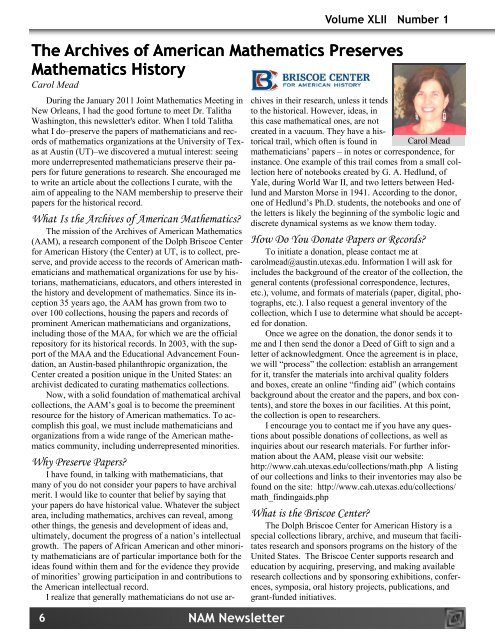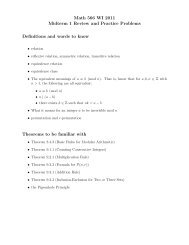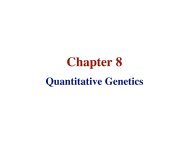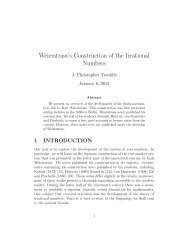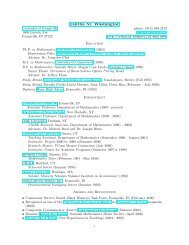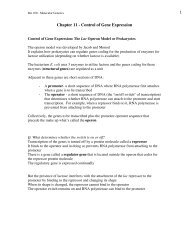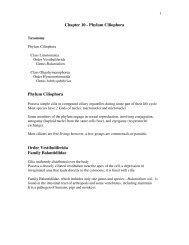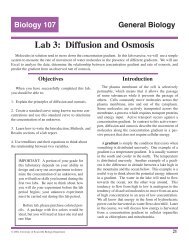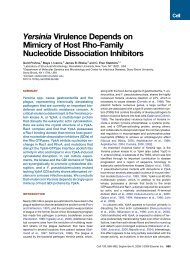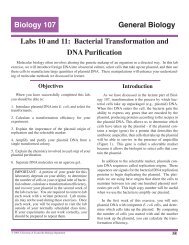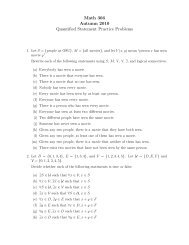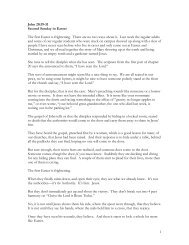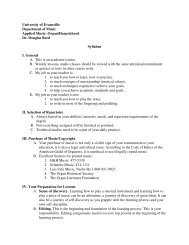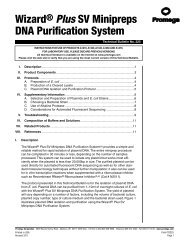NAM Newsletter - University of Evansville
NAM Newsletter - University of Evansville
NAM Newsletter - University of Evansville
You also want an ePaper? Increase the reach of your titles
YUMPU automatically turns print PDFs into web optimized ePapers that Google loves.
6<strong>NAM</strong> <strong>Newsletter</strong>Volume XLII Number 1The Archives <strong>of</strong> American Mathematics PreservesMathematics HistoryCarol MeadDuring the January 2011 Joint Mathematics Meeting inNew Orleans, I had the good fortune to meet Dr. TalithaWashington, this newsletter's editor. When I told Talithawhat I do–preserve the papers <strong>of</strong> mathematicians and records<strong>of</strong> mathematics organizations at the <strong>University</strong> <strong>of</strong> Texasat Austin (UT)–we discovered a mutual interest: seeingmore underrepresented mathematicians preserve their papersfor future generations to research. She encouraged meto write an article about the collections I curate, with theaim <strong>of</strong> appealing to the <strong>NAM</strong> membership to preserve theirpapers for the historical record.What Is the Archives <strong>of</strong> American Mathematics?The mission <strong>of</strong> the Archives <strong>of</strong> American Mathematics(AAM), a research component <strong>of</strong> the Dolph Briscoe Centerfor American History (the Center) at UT, is to collect, preserve,and provide access to the records <strong>of</strong> American mathematiciansand mathematical organizations for use by historians,mathematicians, educators, and others interested inthe history and development <strong>of</strong> mathematics. Since its inception35 years ago, the AAM has grown from two toover 100 collections, housing the papers and records <strong>of</strong>prominent American mathematicians and organizations,including those <strong>of</strong> the MAA, for which we are the <strong>of</strong>ficialrepository for its historical records. In 2003, with the support<strong>of</strong> the MAA and the Educational Advancement Foundation,an Austin-based philanthropic organization, theCenter created a position unique in the United States: anarchivist dedicated to curating mathematics collections.Now, with a solid foundation <strong>of</strong> mathematical archivalcollections, the AAM‘s goal is to become the preeminentresource for the history <strong>of</strong> American mathematics. To accomplishthis goal, we must include mathematicians andorganizations from a wide range <strong>of</strong> the American mathematicscommunity, including underrepresented minorities.Why Preserve Papers?I have found, in talking with mathematicians, thatmany <strong>of</strong> you do not consider your papers to have archivalmerit. I would like to counter that belief by saying thatyour papers do have historical value. Whatever the subjectarea, including mathematics, archives can reveal, amongother things, the genesis and development <strong>of</strong> ideas and,ultimately, document the progress <strong>of</strong> a nation‘s intellectualgrowth. The papers <strong>of</strong> African American and other minoritymathematicians are <strong>of</strong> particular importance both for theideas found within them and for the evidence they provide<strong>of</strong> minorities‘ growing participation in and contributions tothe American intellectual record.I realize that generally mathematicians do not use archivesin their research, unless it tendsto the historical. However, ideas, inthis case mathematical ones, are notcreated in a vacuum. They have a historicaltrail, which <strong>of</strong>ten is found inCarol Meadmathematicians‘ papers – in notes or correspondence, forinstance. One example <strong>of</strong> this trail comes from a small collectionhere <strong>of</strong> notebooks created by G. A. Hedlund, <strong>of</strong>Yale, during World War II, and two letters between Hedlundand Marston Morse in 1941. According to the donor,one <strong>of</strong> Hedlund‘s Ph.D. students, the notebooks and one <strong>of</strong>the letters is likely the beginning <strong>of</strong> the symbolic logic anddiscrete dynamical systems as we know them today.How Do You Donate Papers or Records?To initiate a donation, please contact me atcarolmead@austin.utexas.edu. Information I will ask forincludes the background <strong>of</strong> the creator <strong>of</strong> the collection, thegeneral contents (pr<strong>of</strong>essional correspondence, lectures,etc.), volume, and formats <strong>of</strong> materials (paper, digital, photographs,etc.). I also request a general inventory <strong>of</strong> thecollection, which I use to determine what should be acceptedfor donation.Once we agree on the donation, the donor sends it tome and I then send the donor a Deed <strong>of</strong> Gift to sign and aletter <strong>of</strong> acknowledgment. Once the agreement is in place,we will ―process‖ the collection: establish an arrangementfor it, transfer the materials into archival quality foldersand boxes, create an online ―finding aid‖ (which containsbackground about the creator and the papers, and box contents),and store the boxes in our facilities. At this point,the collection is open to researchers.I encourage you to contact me if you have any questionsabout possible donations <strong>of</strong> collections, as well asinquiries about our research materials. For further informationabout the AAM, please visit our website:http://www.cah.utexas.edu/collections/math.php A listing<strong>of</strong> our collections and links to their inventories may also befound on the site: http://www.cah.utexas.edu/collections/math_findingaids.phpWhat is the Briscoe Center?The Dolph Briscoe Center for American History is aspecial collections library, archive, and museum that facilitatesresearch and sponsors programs on the history <strong>of</strong> theUnited States. The Briscoe Center supports research andeducation by acquiring, preserving, and making availableresearch collections and by sponsoring exhibitions, conferences,symposia, oral history projects, publications, andgrant-funded initiatives.


